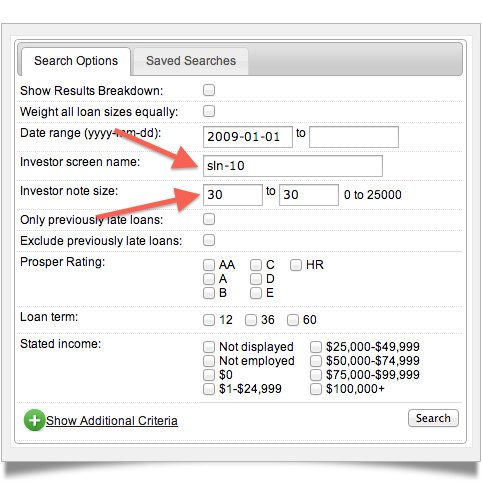One of the nice features on Lending Club is the ability to assign notes to different portfolios. This way you can group notes with the same investment criteria together and see how they perform over time.
There are a couple of third party tools that allow Lending Club investors to analyze their portfolios. I wrote about the Nickel Steamroller Portfolio Analysis tool when it was released in December last year and I continue to use it regularly. Now sites like Interest Radar not only give you a detailed portfolio breakdown but also can monitor the notes in your portfolio for you. Suffice it say that many investors on Lending Club use portfolios as an important part of their investment strategy.
But what about Prosper? They do not allow investors to allocate notes to a portfolio – that concept doesn’t exist on Prosper. So, how does a Prosper investor setup de facto portfolios?
While it is not as elegant as Lending Club it is actually quite easy to implement a pseudo portfolio system. To do this, though, we can’t just rely on the Prosper website; we need to use the third party statistics site Prosper Stats (see my recent Prosper Stats review) as well.
Use Different Note Amounts
Here is how I have setup my “portfolios” on Prosper. First, I should share that I have four different loan filters that I have setup with Automated Quick Invest and I would like to group these notes into four portfolios. I differentiate between these filters by using a different investment amount per note. It is that simple. I use $50, $60, $75 or $100 note sizes and I have also used $25 and $30 in the past.
I can track these portfolios quite easily in Prosper Stats. And I can compare my different strategies to see how they are performing. To do this you just enter your screen name into Prosper Stats and then the note size as you can see in the above screenshot. This will provide an estimated ROI on your portfolio that you can track over time.
What About People Who Want to Stick with $25 Notes
I am always talking about diversification and I wouldn’t want investors to move to $50 notes when they really want to invest $25 per note. One of the advantages of Prosper over Lending Club is that you can invest any amount of $25 or more in a note. So, if you want to maintain full diversification and you have, say, three different filters you would like to track then invest $25, $26 and $27 for each filter.
Here is a bonus tip for you on this. When you register at Prosper Stats you can save your searches. This includes those searches where your own screen name is part of the search criteria. What I have done is setup my Saved Searches on Prosper Stats to match the same name as my Automated Quick Invest searches – this provides some consistency that makes it easier to keep track of my Prosper portfolios.
What do you think Prosper investors? Is tracking portfolios important to you? I am interested to hear your comments.


